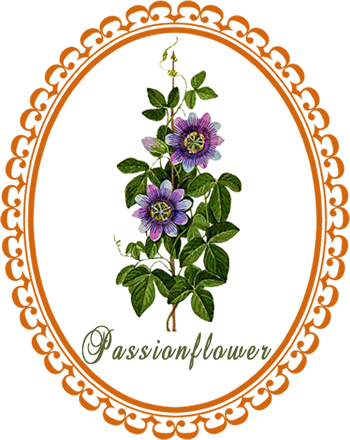
Passionflower: the leaves and stems provide a non-drowsy sedative for insomnia and anxiety, and can prevent a rapid heartbeat, reduce high blood pressure and relieve muscle tension...
Common Names: Passionflower, Passionvine, Maypop
Botanical Name: Passiflora incarnata
Family: Passifloraceae
Plant Type: Climbing vine
Parts Used: Flowers, fruit, leaves, stems
Flowering: May and July
Native to eastern and southern parts of North America, passionflower inhabits thickets, fence lines, and the edges of woodlands. It is widely cultivated in Europe.
Description: Passionflower is a climbing vine with stems 10 to 30 feet long; it climbs with coiled tendrils. It has large white-and-violet flowers and deeply lobed leaves. The flowers are succeeded by yellow-orange, egg-shaped fruits about the size of a hen's egg, known as maypops, that are filled with small seeds embedded in an edible, sweet yellow pulp.
Cultivation: Passionflower is a tender perennial, hardy only to zone 7. Passionflower can be cultivated outside its native habitat as long as it has some protection from wind and frost, although the fruit may not ripen. Passionflower thrives in relatively poor, acidic, sandy soils in full sun where it has something to climb. The plant can be grown from seed, cuttings, or by dividing the rhizomous runners.
Harvesting: Collect the leaves just before the plant flowers. Flowering shoots are typically harvested after the first fruits have matured. Cuttings can be used fresh or dried for use in pills, teas, tinctures, and infusions.
Passionflower Magick
Peace. Sleep. Friendships
Gender: Feminine
Planet: Venus
Element: Water
Place under your pillow to promote sleep.
Carry passionflower to attract friends and great popularity.
Grow passionflower in your home to promote peace and calm troubles.
Passionflower and the Passion of Christ
In the 17th century, Jesuit missionaries working in South America professed to see symbols of the crucifixion in the plant's blossoms.
- The three styles of the pistil so prominent in the center were said to represent the three nails used to nail Christ to the cross.
- The five anthers on the stamens stood for the five wounds in his body.
- The dramatic corona of white and purple threadlike filaments that surrounds these plant parts was thought to resemble the legendary crown of thorns.
- The five sepals and five similar petals beneath this corona were said to symbolize the ten apostles - leaving out Peter and Judas Iscariot, who both betrayed Christ.
- The lobed leaves and tendrils symbolized the hand and whips of his tormentors.
- The flower's colors - white and purple - symbolized purity and heaven.
Herbal Healing with Passionflower
Medicinal Actions: analgesic, antiemetic, anti-inflammatory, antineuralgic (mild), antispasmodic, calmative, hypnotic, hypotensor, nervine, relaxant, sedative, tranquilizer
Medicinal Uses: Passionflower is the first herb of choice for adults who cannot sleep. It helps to ensure a restful night, with no hangover feeling in the morning, unlike many conventional sleeping pills. Its sedative quality also makes it useful for those suffering from anxiety attacks and nervousness. Try it with skullcap (Scutellaria), hops (Humulus), California poppy(Eschscholzia), or wild lettuce (Lactuca). In any situation where stress is a factor, passionflower may be worth trying. Take it last thing at night for insomnia, or regularly during the day for nervous problems.
The leaves offer a remedy for nausea caused by drug withdrawal and reduce the brain's perception of nerve pain; passiflora is an antiseptic and slightly painkilling, and can be used to help manage illnesses like Parkinson's disease or mild epilepsy, to reduce the pain of neuralgia and shingles, and to relax the airways and reduce the physical and emotional tension that comes with asthma.
Passionflower contains a flavonoid, apigen, which is known to have antispasmodic and anti-inflammatory actions which has been used in the cardio-vascular system to ease high blood pressure, and quiet palpitations. In other systems it is used to ease muscle spasm and as a relaxant in diverticulitis and irritable bowel syndrome.
Contraindications
Avoid the use of passionflower during pregnancy.
Body Care with Passionflower
- To treat stress-related insomnia, drink 1 cup passionflower "sweet sleep tea" before bed, as required.
- To lower stress-related high blood pressure, or ease heart palpitations or indigestion, take 1 cup passionflower leaf infusion up to three times daily.
- To soothe minor skin irritations, make a compress using double-strength passionflower leaf infusion; apply to the affected areas.
Sweet Sleep Tea: Steep 1/2 teaspoon dried passionflower leaf, 1/2 teaspoon dried blue skullcap leaf and 1/2 teaspoon dried valerian root in 1 cup just-boiled water for 10 minutes. Strain
Infusion: 1/2 - 1 teaspoon dried passionflower leaves in 1 cup just-boiled water. For double-strength, use 1 - 2 teaspoons dried leaves in 1 cup water.
If you appreciate the information provided,
please help keep this website running. Blessings!
© 2008-2025 aromaworx.ca. All rights reserved.

